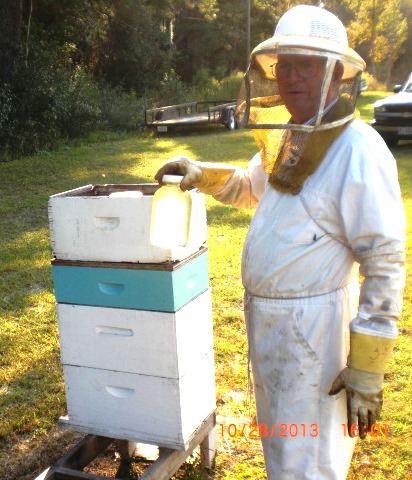Normally a well-managed colony will require little supplemental feeding, but such feeding, when it is necessary, may determine the ultimate survival of the colony. Ensuring that bees always have an adequate food supply is a form of insurance, and it is generally a profitable investment. A colony which has a surplus of food from foraging on natural sources will not eat supplemental feed just because it is available. However, the colony that is short of necessary food stores can starve to death during the winter without it.
Feeding bees can be done in several different ways and there is a small variety of foodstuffs that can be fed to bees. Bees may be fed stored honey, isomerized corn syrup (high fructose corn syrup), and of course, sucrose or table sugar.
Honey is the simplest product to feed the bees when their food stores are in short supply. Some beekeepers will save frames filled with honey so that they will be able to feed their bees when necessary. The feeding of honey already in frames requires very little preparation and the frames can be placed in the hive near the bee cluster.
Extracted honey may also be fed to bees, but it requires more work than using honey already in combs. If extracted honey is used, then the beekeeper should be certain that it came from a disease-free source.
Sucrose or table sugar is still the most commonly used bee feed. The sucrose may be fed in solid (dry), liquid, or in candy type forms. The form chosen is influenced by the condition of the colony, the weather, or time of year. One word of caution, bees can completely digest sucrose, but sugar products that have other components such as starches and sugars other that sucrose, may present problems to the bees.
Isomerized corn syrup, commonly call high fructose corn syrup, is also a substance that can be fed to bees. It is made by converting starch to glucose and then some of the glucose to fructose. The fact that the product contains both fructose and glucose makes its composition similar to that found in real honey.
Sugar syrup is probably the most popular way to feed bees that are low in food stores, though the use of high fructose corn syrup is becoming more common among commercial beekeepers. Sugar syrup is basically a mixture of sucrose in water. The mixtures are generally one part sugar to one part water (by volume) for a thin mixture or two parts sugar to one part water (by volume) for heavy mixtures.
What not to feed:
●Never feed bees honey that comes from an unknown source. Honey can contain spores of diseases such as American Foul Brood.
●Never feed bees sugar with additives. Brown sugar contains molasses. Powdered sugar often contain cornstarch. Commercial fondant may contain flavoring and/or colorings. Any of these “extras” could cause honey bee dysentery.
●Although many commercial beekeepers use high-fructose corn syrup, be aware that it may contain Hydromethyifarfural (HMF) especially if it is cold or has gotten too warm. HMF is poisonous to bees.
How to feed:
●If temperatures are warm (above 50°F) you can use liquid feed in one of the available internal feeders so your bees don’t have to go outside to eat.
●If temperatures are going to be cold, you can use a candy board, or an empty shallow super placed under the hive lid but over the upper-most box containing bees. The super can be filled with sugar cakes, or even liquid feed in one of the various feeder types.
●In colder months, it is always best to put feed over the cluster so the bees can have direct access to it. If you elect to feed liquid food over the cluster, you must make sure your feeder does not leak. Leaking feeders in the winter can be a major stressor to clustering bees.
●Nectar availability is typically low in fall and winter. As such, colonies are more prone to rob one another this time of year. Make sure that your feeders are “clean,” especially after being filled with sugar water as it can attract robbing bees.
When to feed:
●Colonies need about 75, or more, pounds of honey to survive winter.
●If a hive feels light in the fall; you should start feeding liquid sugar syrup (2 parts sugar to one part water by volume) as soon as possible. When the temperature starts dipping below 50°F, switch to one of the cold-weather methods.
●In any case, check the hives on the occasional dry and sunny days. Move frames of honey closer to the cluster, if possible, or add feed if necessary. Do not be lulled into thinking that they have “made it through winter” just because the temperatures are warming in the spring.
Sources of Information:
“The Hive and the Honey Bee” by 1992 Edition
Winter Feeding of Honey Bees – Honey Bee Suite

A colony which has a surplus of food from foraging on natural sources will not eat the supplemental feed just because it is available. However, the colony that is short of necessary food stores can starve to death during the winter. Photo Credit: Doug Mayo.
- Things to Consider When Moving Honey Bee Hives - May 29, 2015
- Honeybees are Valuable Pollinators - December 19, 2014
- Manage Honey Bees Now to Prepare for Next Year’s Nectar Flow - August 1, 2014

